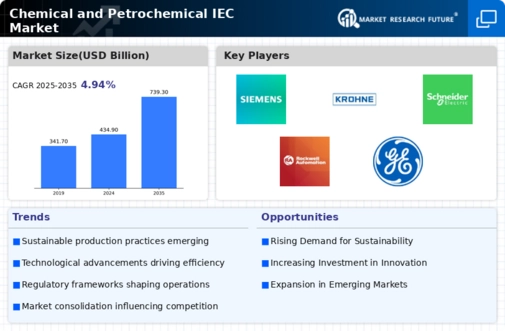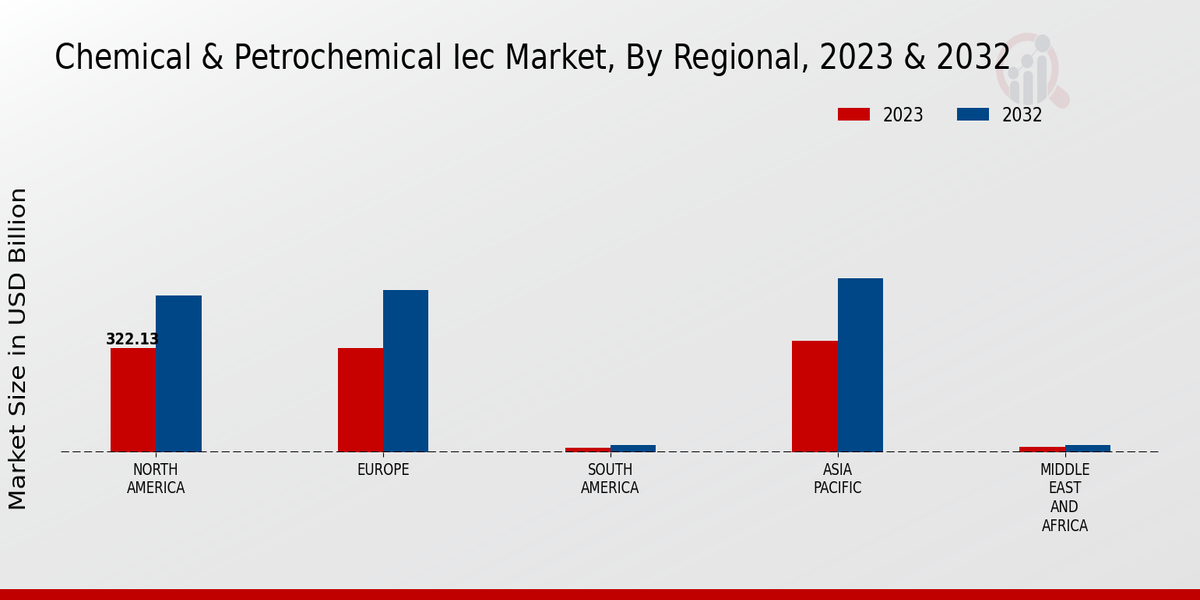Market Growth Projections
The Global Chemical and Petrochemical IEC Market Industry is projected to experience substantial growth over the coming years. With a market valuation of 434.9 USD Billion anticipated in 2024, the industry is expected to reach 739.3 USD Billion by 2035. This growth trajectory indicates a robust compound annual growth rate of 4.94% from 2025 to 2035. Such projections reflect the increasing demand for chemical products across various sectors, driven by technological advancements, sustainability initiatives, and expanding applications. The market's resilience and adaptability suggest a promising future for stakeholders involved in the chemical and petrochemical sectors.
Rising Demand for Sustainable Chemicals
The Global Chemical and Petrochemical IEC Market Industry is witnessing an increasing demand for sustainable and eco-friendly chemicals. This shift is largely driven by regulatory pressures and consumer preferences for greener products. Governments worldwide are implementing stringent regulations aimed at reducing carbon footprints, which encourages manufacturers to innovate and adopt sustainable practices. As a result, the market is projected to grow significantly, with a valuation of 434.9 USD Billion in 2024. This trend not only aligns with environmental goals but also opens new avenues for investment and development in sustainable chemical technologies.
Expanding Applications Across Industries
The versatility of chemicals and petrochemicals is driving their adoption across various industries, thereby propelling the Global Chemical and Petrochemical IEC Market Industry. Sectors such as automotive, construction, and pharmaceuticals increasingly rely on chemical products for manufacturing and innovation. For example, the automotive industry utilizes advanced polymers and composites for lightweight vehicles, enhancing fuel efficiency. This broad application spectrum is expected to sustain market growth, with projections indicating a market size of 739.3 USD Billion by 2035. As industries continue to evolve, the demand for specialized chemical solutions is likely to expand further.
Global Population Growth and Urbanization
The ongoing global population growth and urbanization trends are significant drivers of the Global Chemical and Petrochemical IEC Market Industry. As urban areas expand, the demand for housing, infrastructure, and consumer goods rises, leading to increased consumption of chemicals and petrochemicals. This demographic shift necessitates the development of new materials and products to meet the needs of growing urban populations. Consequently, the market is positioned for robust growth, with an anticipated valuation of 434.9 USD Billion in 2024. Urbanization not only fuels demand but also encourages innovation in chemical applications to address urban challenges.
Regulatory Support for Petrochemical Innovations
Regulatory frameworks are increasingly supportive of innovations within the Global Chemical and Petrochemical IEC Market Industry. Governments are recognizing the importance of the petrochemical sector in driving economic growth and are implementing policies that promote research and development. This support is crucial for fostering innovation in areas such as bio-based chemicals and recycling technologies. As a result, companies are incentivized to invest in new solutions that align with regulatory goals. This trend is expected to contribute to the market's expansion, with a projected CAGR of 4.94% from 2025 to 2035.
Technological Advancements in Production Processes
Technological innovations play a pivotal role in shaping the Global Chemical and Petrochemical IEC Market Industry. Advanced production techniques, such as digitalization and automation, enhance efficiency and reduce operational costs. For instance, the integration of artificial intelligence and machine learning in production processes allows for real-time monitoring and optimization, leading to improved yield and reduced waste. These advancements are expected to contribute to the market's growth trajectory, with a projected CAGR of 4.94% from 2025 to 2035. Consequently, companies that embrace these technologies are likely to gain a competitive edge in the evolving landscape.

















Leave a Comment